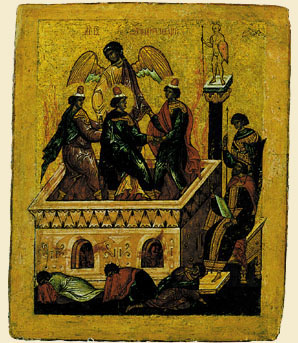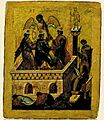Nativity Fast facts for kids
The Nativity Fast is a special time for many Christians. It's a period of prayer and simple eating. Christians prepare for the birth of Jesus on December 25. This fast is practiced by the Eastern Orthodox Church, Oriental Orthodox Church, and some parts of the Catholic Church.
In the Ethiopian Orthodox Tewahedo Church and Eritrean Orthodox Tewahedo Church, it's called the Fast of the Prophets. They start their fast on November 24. It ends on January 7, which is their Christmas Day.
In Western Christianity, a similar time is called Advent. Advent usually lasts four or six weeks. The Eastern Nativity Fast is longer, lasting 40 days. It focuses on celebrating God becoming human. Western Advent focuses on Jesus' first coming (his birth) and his Second Coming.
The Byzantine fast starts on November 15 and ends on December 24. These dates are for churches using the Revised Julian calendar. This calendar matches the Gregorian calendar we use today.
Some Eastern Orthodox churches still use the old Julian calendar. These include the Russian Orthodox Church and the Serbian Orthodox Church. For them, the fast starts on November 28 (Gregorian calendar). This date is November 15 on their Julian calendar.
Sometimes, the fast is called Philip's Fast. This is because it begins after the Feast of St. Philip the Apostle on November 14. Some churches, like the Melkite Greek Catholic Church, start the fast later, on December 10.
Contents
Why do people fast?
Fasting is a way to focus on spiritual things. When people fast, they try to control their desire for food. This helps them control other desires too. It's believed that this helps the soul turn away from worldly needs. Instead, it focuses more on spiritual needs.
Through fasting and prayer, people feel closer to Christ. They believe it helps them become more like Christ. Fasting involves the body, but its main goal is spiritual. In Eastern Orthodox belief, the body and soul are connected. What affects one can affect the other.
Rules for fasting

During the Nativity Fast, people traditionally avoid certain foods. These include red meat, poultry, eggs, dairy products, fish, oil, and wine.
However, there are some exceptions:
- On Saturdays and Sundays, fish, wine, and oil are usually allowed.
- On most Mondays, Tuesdays, and Thursdays, oil and wine are allowed.
- On certain feast days during the fast, fish, wine, and oil are also permitted. Examples include the feasts of Evangelist Matthew (November 16) and St. Nicholas (December 6).
The Nativity Fast is not as strict as Great Lent or the Dormition Fast.
Some people are excused from fasting. These include those who are ill, very young children, the elderly, and nursing mothers. People usually talk to their confessor (a priest) about any exceptions. It's important never to put your health in danger.
From December 20 to December 24, the rules become stricter. No fish is allowed during these days.
The Eve of Nativity (December 24) is a very strict fast day. It's called Paramony. On this day, people usually don't eat solid food. They wait until the first star appears in the evening sky. Or they wait until after the special evening church service. If Paramony falls on a Saturday or Sunday, the fast is less strict. A meal with wine and oil is allowed after the morning church service.
Church services during the fast
During the Nativity Fast, church services on weekdays are similar to those during Great Lent. Many churches in the Russian tradition have special services on the first day of the fast. Sometimes, the church decorations are changed to a more serious, Lenten color.
Throughout the fast, there are feast days for Old Testament prophets. These prophets spoke about God becoming human. Examples include Obadiah (November 19) and Daniel (December 17). Daniel and the Three Holy Youths are important. They showed great strength by fasting. Their survival in the fiery furnace is seen as a symbol. It reminds people of how the Virgin Mary received God in her womb. She was not harmed by God's power.
A very important feast day happens during the fast. It is the Entry of the Theotokos (November 21). After this feast, special hymns about the Nativity are sung on Sundays and other important feast days.
Forefeast
The time right before Nativity is called the Forefeast. It starts on December 20 and ends on December 24. During these days, hymns about the Nativity are sung daily. In Russian churches, the church decorations often change to a festive white color at the start of the Forefeast.
Sunday of the Forefathers
Two Sundays before Nativity, the church remembers its ancestors. These are people from the Bible who lived before and after Moses' Law. They include Adam, Noah, Abraham, Isaac, Jacob, and King David.
Special hymns are sung on this day. They honor these biblical figures, including Daniel and the Three Young Men. There are also specific Bible readings for the church service.
Sunday of the Holy Fathers
The Sunday right before Nativity remembers even more righteous people. It includes all good men and women who pleased God from the creation of the world up to Saint Joseph. This day has even more special hymns and readings. For example, a reading from the book of Hebrews is shared.
Paramony
Christmas Eve (December 24) is called Paramony. It is a very strict fast day. People who are able often do not eat until the first star is seen at night. Or they wait until after the special evening church service.
On this day, special services called the Royal Hours are held in the morning. Some of the hymns are similar to those sung on Theophany (Epiphany) and Great and Holy Friday. This connects Christ's birth to his death on the Cross. After the Royal Hours, a special church service called the Vesperal Divine Liturgy of St. Basil is held.
During this service, eight readings from the Old Testament are shared. These readings hint at or predict the birth of Christ. If Christmas Day falls on a Sunday or Monday, the Royal Hours are moved to the previous Friday. On Paramony, the fast is less strict, and a meal with wine and oil is allowed after the morning service.
On the night of December 24, there is a long evening service called the All-Night Vigil. A special part of this service is singing "God is with us!" This is mixed with verses from the prophecy of Isaiah. These verses speak about the triumph of God's Kingdom and the birth of the Messiah.
The main church service for the Nativity of Christ is held on Christmas morning. In some monasteries, the All-Night Vigil lasts all night. It leads directly into the Christmas morning service. If the Vigil and the morning service are separate, the fast continues until the morning service ends.
Fasting after Christmas
The time after Christmas Day is called the Afterfeast of the Nativity of Christ. It begins on December 25. From this day until January 4, there is no fasting. January 5, the Eve of the Theophany, is another strict fast day.
Coptic fast
In the Coptic Orthodox Church, there is an extra fast. It happens for three days before the Nativity Fast begins. This fast remembers a miracle. A mountain near Cairo was moved by Saint Simon the Tanner in the year 975.
Armenian fast
The Armenian Apostolic Church celebrates Nativity on January 6. Their Fast of Advent starts seven Sundays before Christmas. They then have a Fast of the Nativity for one week before January 6.
See also
 In Spanish: Ayuno de Natividad para niños
In Spanish: Ayuno de Natividad para niños
- Christmastide
- Great Lent
- Apostles' Fast
- Dormition Fast
Images for kids
-
The Three Young Men in the Fiery Furnace, celebrated during the Nativity Fast as a reminder of the grace acquired through fasting (15th century icon of the Novgorod school).
-
The Entry of the Theotokos into the Temple, the Great Feast which falls during the course of the Nativity Fast (16th-century Russian icon).


